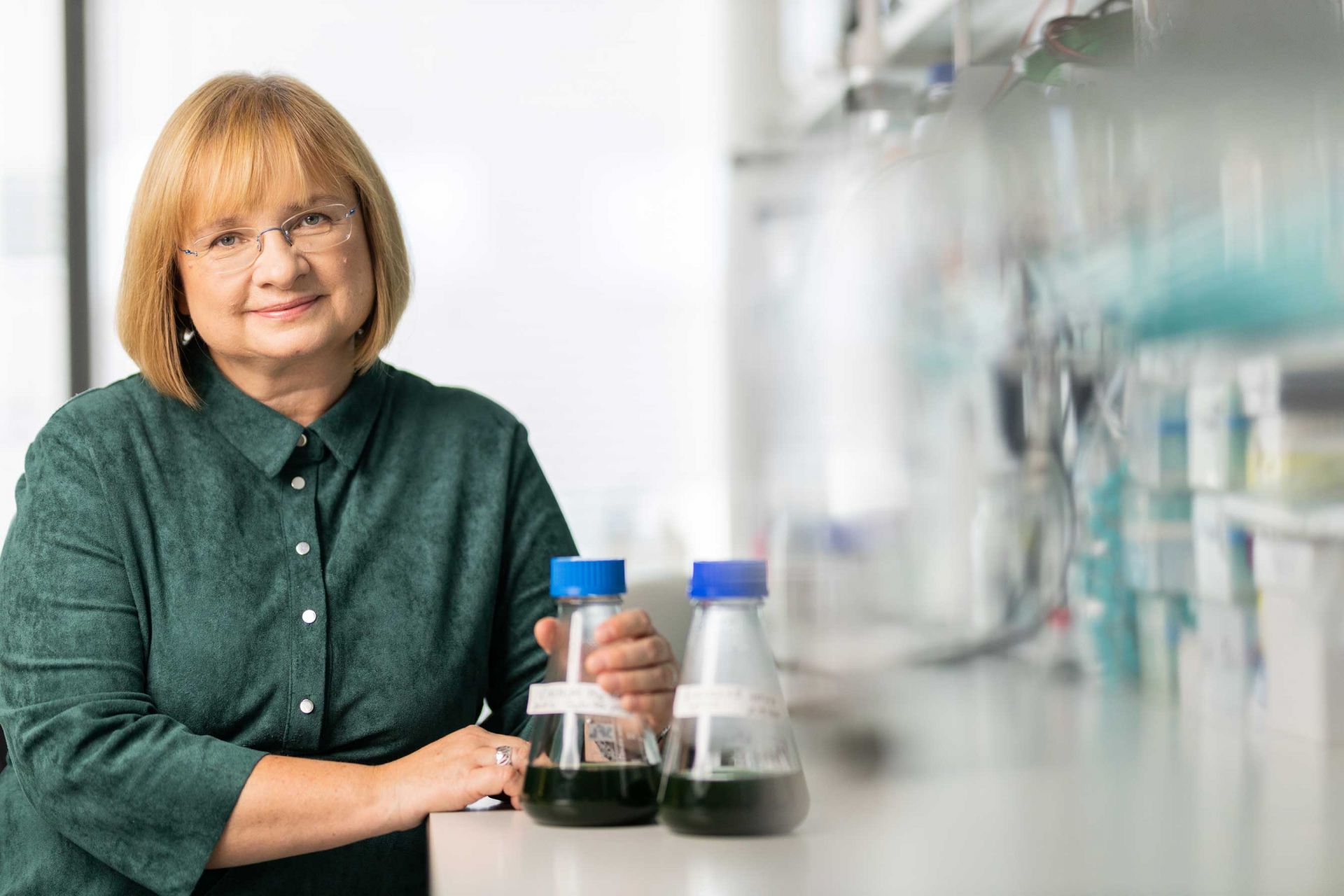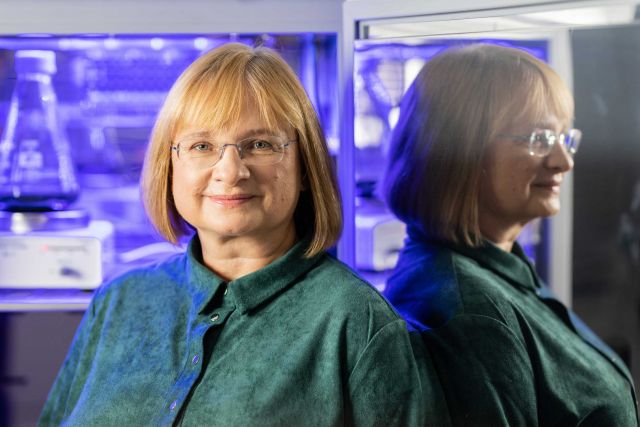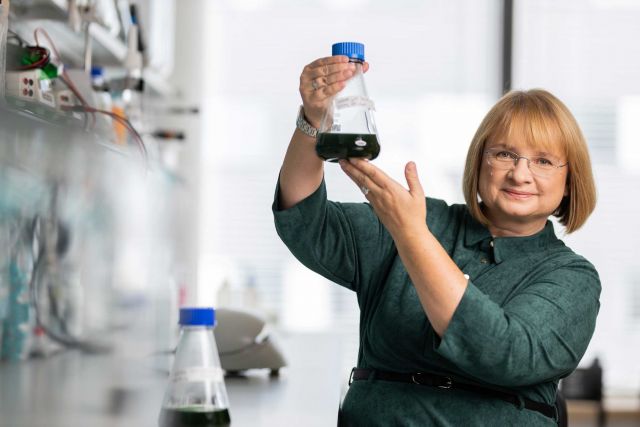Principal Investigator
:
Dr hab. Joanna Monika Kargul, Prof. UW
Centre for New Technologies, University of Warsaw
Panel: NZ1
Funding scheme
: OPUS 8
announced on
15 September 2014
Solar energy powers life on our planet through the fundamental process of photosynthesis. Natural photosystems are made up of large membrane protein complexes, which use spatially organized systems of electron transfer cofactors and pigments to create highly efficient macromolecular nanomachines that convert solar energy into chemical energy. Converting solar power into fuel may serve as the most attractive source of clean energy as the demand for power grows in our time. In an era of global climate change, there is an urgent need to thoroughly study the molecular mechanisms of photosynthesis, especially in extreme conditions similar to those that accompanied the emergence of the first forms of life.
 Photo by Michał Łepecki
The structure of photosynthetic apparatus of Cyanidioschyzon merolae, an extremophilic unicellular red alga harvested from volcanic hot springs implies that this microalga constitutes an evolutionary link between cyanobacteria and higher plants. Our project studied how the photosynthetic apparatus of this thermophilic and acidophilic microalga regulates its function in extreme environmental conditions. For this purpose, we examined: (1) the pattern of dynamic changes in the structure of antenna systems (systems that capture solar power) connected to photosystems I and II (PSI and PSII) in the cells of C. merolae, as influenced by the quantity and spectral quality of available light; (2) water substrate exchange rates in the catalytic centre of PSII (an enzyme that splits water upon absorption of sunlight); (3) the role of carotenoids, i.e. pigments, identified in PSI and PSII complexes obtained from C. merolae, which protect the photosynthetic apparatus from excess sunlight. We also looked into (4) the kinetics of the early processes of solar energy conversion, including the solar energy transfer pathways in photosystems isolated from this extremophilic microalga.
Photo by Michał Łepecki
The structure of photosynthetic apparatus of Cyanidioschyzon merolae, an extremophilic unicellular red alga harvested from volcanic hot springs implies that this microalga constitutes an evolutionary link between cyanobacteria and higher plants. Our project studied how the photosynthetic apparatus of this thermophilic and acidophilic microalga regulates its function in extreme environmental conditions. For this purpose, we examined: (1) the pattern of dynamic changes in the structure of antenna systems (systems that capture solar power) connected to photosystems I and II (PSI and PSII) in the cells of C. merolae, as influenced by the quantity and spectral quality of available light; (2) water substrate exchange rates in the catalytic centre of PSII (an enzyme that splits water upon absorption of sunlight); (3) the role of carotenoids, i.e. pigments, identified in PSI and PSII complexes obtained from C. merolae, which protect the photosynthetic apparatus from excess sunlight. We also looked into (4) the kinetics of the early processes of solar energy conversion, including the solar energy transfer pathways in photosystems isolated from this extremophilic microalga.
 Photo by Michał Łepecki
Both photosystems isolated from this fascinating extremophile were shown to be exceptionally stable under extreme pH, temperature and light conditions. The quantum efficiency of the water-splitting enzyme (PSII) also remained unchanged regardless of light conditions. Thanks to our highly interdisciplinary approach, which employed biochemical, biophysical, proteomic, and advanced microscopic imaging methods to study individual photosynthetic complexes, we were able to define the following molecular mechanisms by which the photosynthetic apparatus of C. merolae adapts to fluctuating light: (i) the accumulation of photoprotective pigments (zeaxanthin and β-carotene) in antenna complexes and photosynthetic reaction centres; (ii) dynamic changes in the structure of antennae and photochemical reaction centres in PSI and PSII complexes, on the level of both proteins and pigments, which improves the use of sunlight for cellular metabolism; and (iii) the same photosynthetic water-splitting reaction kinetics in the PSII complex of C. merolae as in its equivalent in mesophilic organisms.
Photo by Michał Łepecki
Both photosystems isolated from this fascinating extremophile were shown to be exceptionally stable under extreme pH, temperature and light conditions. The quantum efficiency of the water-splitting enzyme (PSII) also remained unchanged regardless of light conditions. Thanks to our highly interdisciplinary approach, which employed biochemical, biophysical, proteomic, and advanced microscopic imaging methods to study individual photosynthetic complexes, we were able to define the following molecular mechanisms by which the photosynthetic apparatus of C. merolae adapts to fluctuating light: (i) the accumulation of photoprotective pigments (zeaxanthin and β-carotene) in antenna complexes and photosynthetic reaction centres; (ii) dynamic changes in the structure of antennae and photochemical reaction centres in PSI and PSII complexes, on the level of both proteins and pigments, which improves the use of sunlight for cellular metabolism; and (iii) the same photosynthetic water-splitting reaction kinetics in the PSII complex of C. merolae as in its equivalent in mesophilic organisms.
We need to know these precise molecular mechanisms that regulate the high stability and photoprotection of the photosynthetic apparatus of the extremophilic unicellular alga C. merolae so as to understand the processes of efficient solar energy conversion and cellular energy homeostasis in extreme environmental conditions. The research has a high translational potential. It will facilitate the development of better strategies for manufacturing stable and efficient biomimetic devices to convert solar energy into clean fuels under extreme conditions, thus promoting a more efficient production of clean energy.
Project title: Structural and functional characterisation of the photosynthetic apparatus of an extremophilic red microalga Cyanidioschyzon merolae
Dr hab. Joanna Monika Kargul, Prof. UW
Head of the Solar Fuels Lab at the Centre for New Technologies, University of Warsaw. She got her PhD in biological sciences in 1999 from the University of Warwick (UK), and completed a postdoctoral fellowship in a group led by Professor James Barber at Imperial College London, where she studied the structure and function of photosynthetic complexes. Her research led to the ground-breaking discovery of unique molecular mechanisms that govern rapid photosynthetic adaptation to changing environments. She earned her habilitation degree at the Faculty of Biology, University of Warsaw in 2009. In 2011, upon her return from London to Warsaw, she set up an interdisciplinary international team of biologists and chemists to conduct basic and applied research into the fundamental processes of natural photosynthesis, as well as the production of so-called solar fuels in biomolecular devices for artificial photosynthesis.


